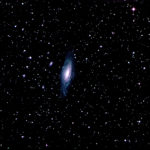Astronomy is one of those topics that naturally generates enthusiasm. Contemplatingthe sheer scale of the universe and our place in it is a truly humbling and awe-inspiring experience. The teacher in me loves to use that moment when a student is rapt, that moment when they are looking into space saying, "Wow! What is that thing?"
The new observatory give us the opportunity to bring our universe into closer focus. The observatory was built on the top of the Anderson Parking Facility. To mitigate the vibrations created by automobile traffic, the telescope is mounted on a steel pier anchored to a support beam under the floor. It is housed under a domed ceiling thatcan be opened from a computer in the control room or from a wallmounted control panel next to the telescope. And just as important, the domed room is not heated or cooled, as air-temperature changes when the dome is open and can cause enough turbulence to distort the telescope’s image-capture.
One of the first questions asked by someone looking through a telescope for the first time is: "How far can this thing see?" They are, quite naturally, seeking a sense of the power of the telescope. A better question, perhaps, is: "What’s the dimmest object that this thing can see?" The true power of a telescope lies in the amount of light it cangather. The light-gathering power of a telescope is measured by the size of its primary mirror or lens. As of fall 2011, the largest telescope in the world, with a 10.4-meter primary mirror, is the Gran Telescopio Canarias located on the Canary Islands. It is reserved exclusively for cutting-edge astronomical research. Our telescope, a PlaneWave CDK17, sports a 17-inch primary mirror, putting it among the largest amateur instruments and at the small end of those used for research. A large catalog of objects lies within easy reach of our telescope, including planetary targets such as Jupiter and its moons, Saturn and its rings, Mars, Venus and Neptune, as well as "deep sky" objects such as planetary nebula, stellar nurseries and galaxies beyond the Milky Way.
Although our facility clearly can’t compare in scale to the Gran Telescopio Canarias, it intentionally is designed to emulate just such a professional observatory. The telescope is attached to a computercontrolled robotic mount (the AstroPhysics el Capitan) that aims it at the desired astronomical target. An eyepiece can be used for viewing, but most of the time a digital camera will send the images from the telescope to a computer in an adjacent climate-controlled room.
The observatory is integrated into the St. Thomas physics curriculum in several ways. About 200 students a year take Physics 104, an introductory astronomy course with an associated lab, aimed primarily at non-science majors. This course is one of a small number of opportunities that we have to contact non-science students. Our overarching goal is to have them leave the course with a positive attitude toward science and with a solid understanding of the fundamental principles of scientific investigation. Hands-on experience is critical. Using the observatory in the lab, they can gather their own data and see firsthand how it is used to investigate the natural world.
Advanced physics students also can use the observatory to learn about astronomical data analysis, take part in long-term observational projects, or design and implement their own observing programs and research projects.
Read more from St. Thomas magazine









